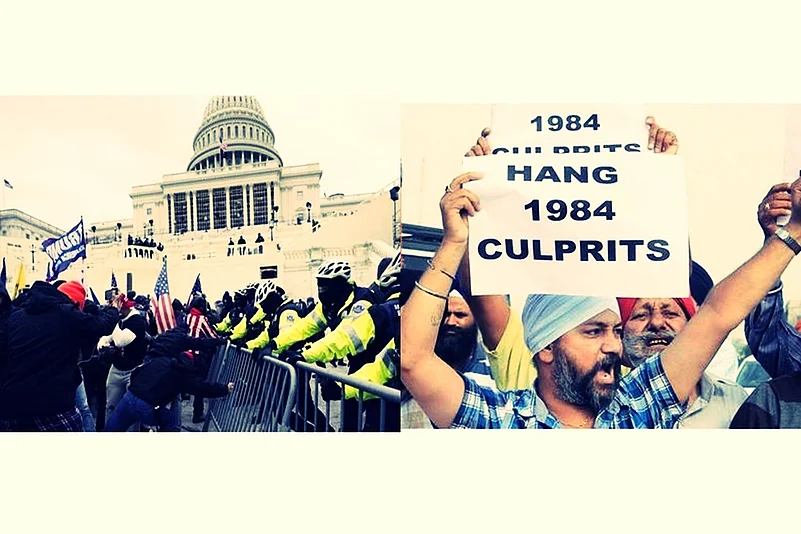A comparative study of the insurrection in Washington DC on 6 January 2021 and the October 1984 Delhi riots against the Sikh community would lead to a conclusion that much violence could have been prevented had the military authorities rushed their manpower to aid the beleaguered local police as provided by law.
In America, the National Guard (NG), a reserve force under the Pentagon, provides aid to civil power through units located at 54 locations in 50 states, overseas territories and at Washington DC. They work under the dual control of President and State governors. Since Washington DC is not a full state, this power is exercised by the DC City Council under Mayor Muriel Bowser.

Although the US Capitol Police is under the US Congress, the concurrent responsibility of law and order is with Washington DC police under the Mayor. On 6th January Mayor Bowser complained on Twitter that the Pentagon refused to allow the District of Columbia National Guard “to restore order at the Capitol Building”. The only person who could have ordered NG speedily to the Capitol was President Trump, who was busy fanning insurrection.
A similar statement was issued by Governor Larry Hogan, the Republican governor of the adjacent state of Maryland. He was “repeatedly” denied permission by the Federal Government to send Maryland State Police troopers and the Maryland National Guard under him to the neighbouring Washington DC. The permission came only 90 minutes later from the Pentagon.
On January 11, The Wall Street Journal (WSJ) confirmed that Pentagon parried Mayor Bowser’s request on mundane bureaucratic grounds asking her why she needed them. They also wanted a request based on “capabilities” rather than the “number”. Even after the permission was granted 90 minutes later, the Guards caused further delay for “retrieving their protective gear”.
Frantic calls from senior congressmen like House majority leader Steny Hoyer and Senate minority leader Chuck Schumer to Governor Larry Hogan to rush in troops were in vain as he did not have the authorisation from Pentagon. Eventually, it was revealed that the clearance was delayed by acting Defense Secretary Chris Miller, who gave his permission to Army Secretary Ryan McCarthy only at 0441pm. By that time most of the violence had already occurred.
While the Capitol violence was instigated by Trump’s delusionary rapacity for power, the 1984 carnage had its origins in the mass anger against Prime Minister Indira Gandhi’s assassination by her Sikh security guards who were deeply disturbed by her action in conducting a military assault on the Sikh holy temple. Yet the mass killings could have been considerably reduced had the Army rushed enough extra manpower to then Delhi Police chief S. C.Tandon, who had requested for that on October 31, 1984 morning itself.
The Central Reserve Police (CRP) used to celebrate its annual day with a parade on October 31 coinciding with the birthday of India’s first Home Minister Sardar Vallabhbhai Jhaverbhai Patel who had retained and renamed the British era Crown Reserve Police. Commissioner Tandon, who was present at this parade, was informed about the Prime Minister’s assassination a few minutes after 9-30 am.
According to the papers filed before Justice Ranganath Misra Commission and later to Justice Nanavati Commission, Tandon’s first act was to talk to Maj. Gen. J.S.Jamwal, Army’s General Officer Commanding to keep his troops on “stand-by”. Tandon was already short staffed since his reserves were sent to troubled Punjab and even to Assam. Jamwal told him that he did not have the troops in Delhi but “would get them by evening”.
Tandon also requested the Union Home Ministry for extra policemen from other states to augment his strength as he had to also provide personal security to the inflow of very important persons from our states and from foreign countries, consequent to the Prime Minister’s assassination. As a result, fifty-one additional police companies reached New Delhi by 1 November morning.
The GOC who had promised army on “stand-by” later insisted on protocol and wanted the requisition to be made by the Lt. Governor. This was strange since S. 130 (2) of the Criminal Procedure Code empowers such requisition by any senior Executive Magistrate, which Tandon was. Even then the Army could spare only 2 battalions in two districts.
[The writer is a former Special Secretary, Cabinet Secretariat]
















